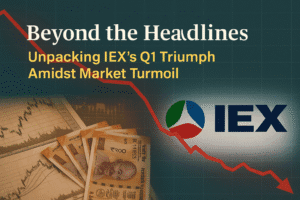Beyond the Headlines: Unpacking IEX’s Q1 Triumph Amidst Market Turmoil
IEX delivered strong Q1 FY26 performance with net profit surging 26% to ₹121 crore and revenue up 15% to ₹142 crore, driven by a 15% increase in electricity volumes (32.4B units) and explosive 149% growth in renewable energy certificate trading. The exchange played a vital role in India meeting its 242 GW peak summer demand through efficient power distribution. However, shares crashed 28% to ₹135.49 immediately after results due to the CERC’s mandate for phased “market coupling” implementation starting January 2026.
This regulatory shift threatens IEX’s dominant position by creating uniform power prices across all exchanges, potentially eroding its near-monopoly pricing power. While operational excellence and growth in gas trading (+109%) and carbon markets remain strengths, investor confidence hinges on IEX’s ability to adapt its business model to this disruptive change. The results highlight a stark contrast between current profitability and future regulatory uncertainty.

Beyond the Headlines: Unpacking IEX’s Q1 Triumph Amidst Market Turmoil
Indian Energy Exchange (IEX), the dominant force in India’s power trading landscape, delivered robust Q1 FY26 results, showcasing significant operational strength. However, a dramatic 28% stock plunge the same day painted a complex picture of triumph overshadowed by regulatory uncertainty. Here’s a deeper dive into the numbers and the forces at play:
Strong Operational Performance:
- Profit & Revenue Surge: IEX reported a 26% YoY jump in net profit, reaching ₹121 crore (up from ₹96 crore in Q1 FY25). Revenue from operations grew 15% YoY to ₹142 crore (vs. ₹124 crore), reflecting healthy core business growth.
- Volume Momentum: Electricity volumes rose 15% YoY to 32.4 Billion Units (BUs). This growth occurred despite a 1.3% YoY dip in national electricity consumption (446 BUs), attributed to cooler weather from early monsoons.
- Renewables Boom: Trading in Renewable Energy Certificates (RECs) skyrocketed by 149% YoY to 52.7 lakh certificates, highlighting the accelerating green transition and IEX’s role in facilitating it.
- Gas Exchange Milestone: The Indian Gas Exchange (IGX), an IEX subsidiary, doubled its traded volume (up 109% YoY) to 24.6 million MMBtu, driven by demand from oil marketing companies and city gas distributors.
- Carbon Market Presence: The International Carbon Exchange (ICX), another IEX subsidiary, issued over 44 lakh International Renewable Energy Certificates (I-RECs), strengthening its position in the sustainability market.
Enabling National Power Resilience: IEX played a critical role as India successfully managed its peak summer demand of 242 GW. Proactive government measures – extending Section 11 for imported coal plants, activating gas-based plants, and ramping up domestic coal supply (leading to a comfortable 25-day inventory) – ensured seamless power availability. This robust supply, coupled with increased hydro and wind generation, boosted liquidity on exchanges.
Market Dynamics Favouring Liquidity & Lower Prices:
- Day-Ahead Market (DAM): Liquidity surged 45.2% YoY, pushing the average price down 16% YoY to ₹4.41 per unit.
- Real-Time Market (RTM): Average prices fell 20% YoY to ₹3.91 per unit, benefiting consumers.
The Regulatory Thunderbolt: Market Coupling: Despite the strong operational performance, IEX shares plummeted 28% to close at ₹135.49. This drastic reaction stemmed entirely from a Central Electricity Regulatory Commission (CERC) order announced the day before the results. The CERC mandated the phased implementation of “Market Coupling” for the Day-Ahead Market segment, starting January 2026.
Why Market Coupling Spooked Investors:
- End of Monopoly Pricing Power: Market coupling creates a single, uniform price for electricity across all power exchanges. This fundamentally challenges IEX’s dominant market share (over 95% in the day-ahead market).
- Threat to Market Share: Coupling could force IEX to compete more directly on factors beyond price discovery (like technology, fees, service), potentially eroding its near-monopoly position as buyers and sellers can use any exchange to access the same price.
- Uncertainty on Profitability: The long-term impact on IEX’s transaction fees, margins, and overall profitability model under this new regime is currently unclear, creating significant investor anxiety.
The Path Forward: IEX’s Q1 results undeniably demonstrate its operational excellence and vital role in India’s power ecosystem. The explosive growth in RECs and IGX volumes points to promising diversification. However, the CERC’s market coupling decision represents a seismic shift. IEX’s future success now hinges critically on its ability to adapt its business model, leverage its brand and technology, and compete effectively in a fundamentally altered landscape post-January 2026.
The story of IEX is now a tale of two halves: strong fundamentals versus disruptive regulatory change. While the company is executing well today, the looming implementation of market coupling casts a long shadow over its historically dominant position and future earnings potential. Investors must weigh the company’s operational strengths against this profound regulatory risk as they assess its long-term value.
You must be logged in to post a comment.